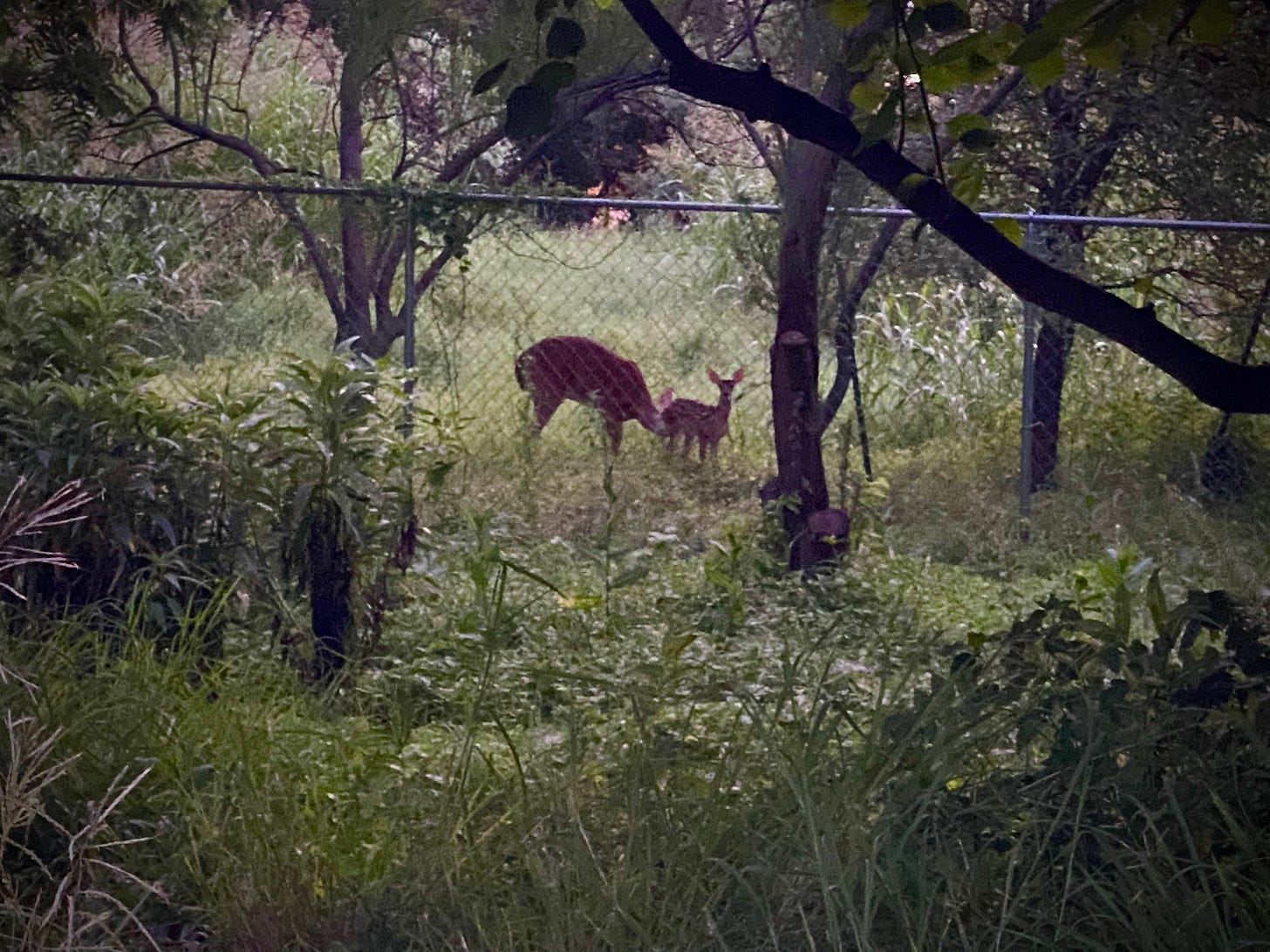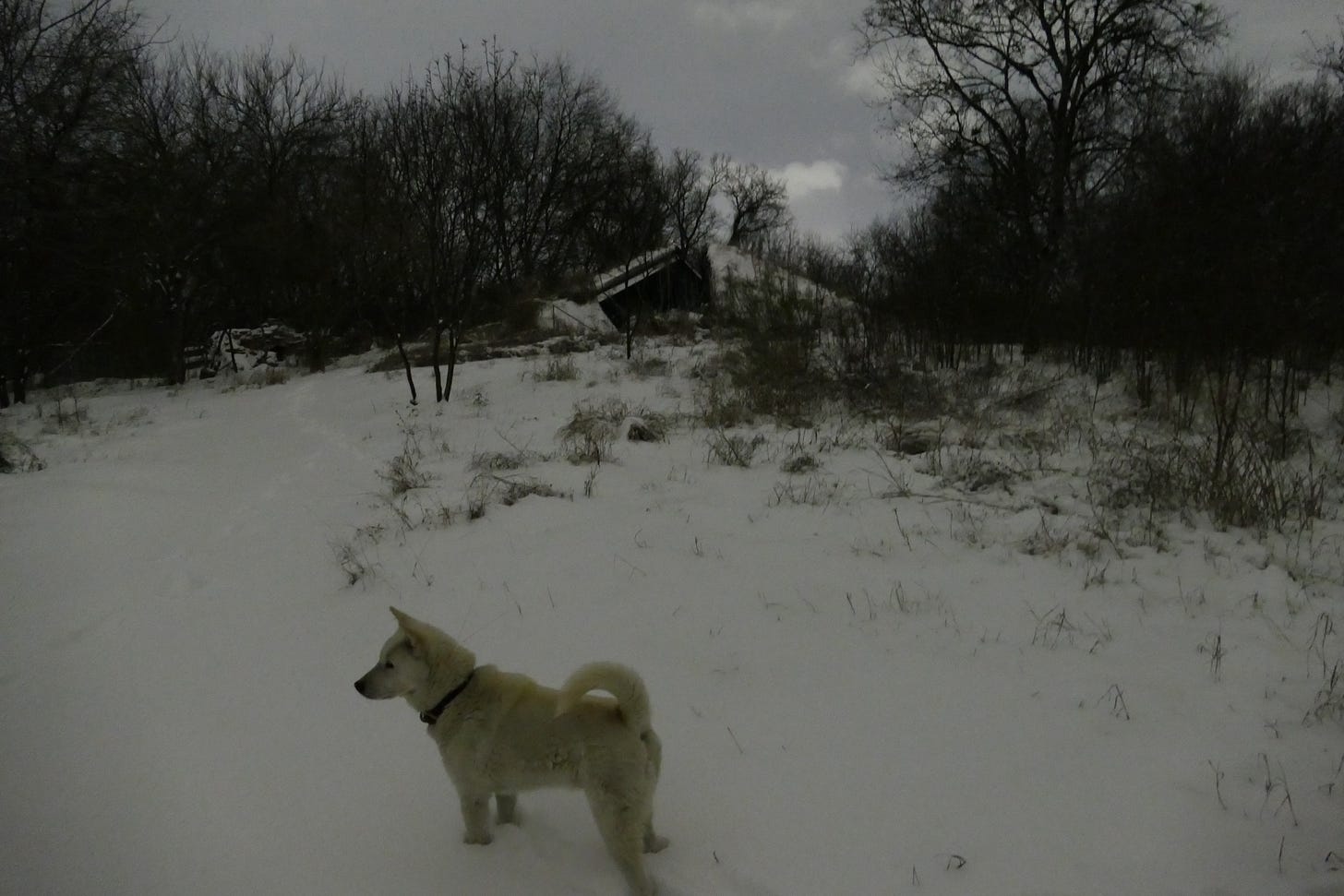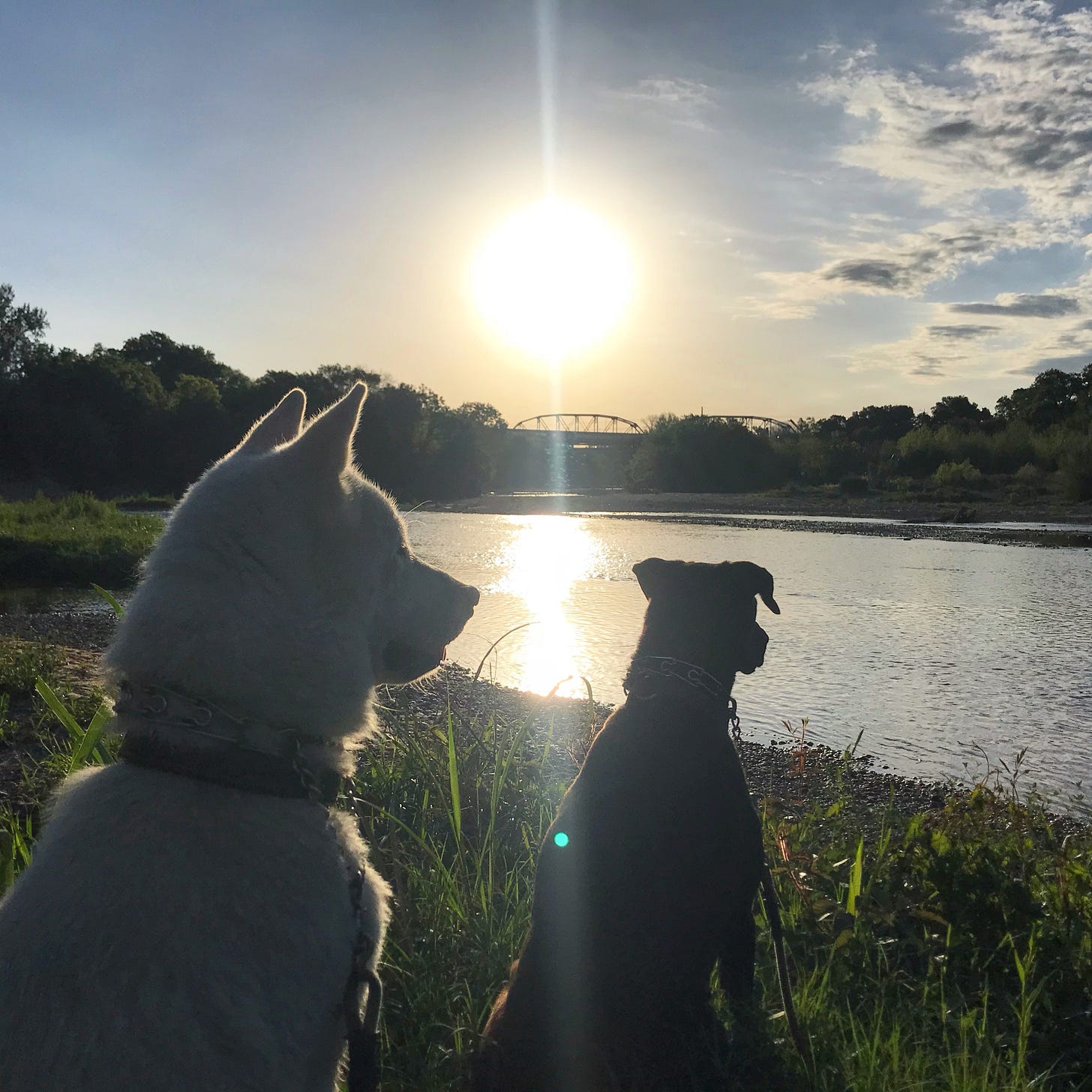Requiem for a hound
Almost every day this week, I found the fragment of a songbird egg in my path. On the sidewalk, mostly, making you wonder where they came from, what the story was. Innocent victims in a struggle we never see.
Maybe it’s true what the eco-nativists say about those starlings that live behind the billboards for lawyers and cash back credit cards.
Saturday morning when I stepped up out of the bunker at daybreak a mama deer and her baby were standing there right at our fence, mama chomping fresh green growth and baby unwarily returning my gaze, as juvenile animals tend to do. They often come up to that field, an empty lot where the old right of way runs behind the door factory, maybe because there are few predators so close to the loading dock. But they rarely come that close to our fence. Maybe they already noticed that the rowdier of our dogs, the one who always patrolled that fence, has gone.
When my son was a teenager, he spent a couple of summers in Japan visiting family on his mom’s side and coming to embrace that part of his identity. He got the idea that he would really like to get a Japanese dog, and that seemed like the kind of thing a parent should embrace. We had just bought this property and moved into a little rental cottage next door while we tried to build our house, and we needed dogs. Our new home was at the end of a little side street at the edge of town, next to a huge swath of urban woods hidden behind an industrial park, a zone where wild animals and weird humans intermingle. A few months earlier we had adopted our East Austin Street Retriever, a six-month-old puppy that had been abandoned down the street with her sister and living on a ratty old couch behind the diner (our neighbors adopted her sister). She could use a companion, and we could use a pack.
What my son really wanted was a Shiba-Inu, one of those little dogs that seem part Pokemon. We met a few. I was impressed by their capacity to leap like furry fleas, but suggested that we find a bigger dog who could be more effective at providing the protection we needed. He didn’t like my idea of an Akita. I said let’s do some more research and find a dog we both like, especially since dog would be staying behind when boy went to college.
To my surprise, he did his research, and found the perfect fit for the job. The Kishu-ken, a medium-sized hound bred from ancient stock in southern Honshu. A dog with a reputation for bonding intensely with the family that adopts it, and a knack for hunting small game. There were only two breeders outside of Japan: one in the Netherlands, and one in Rockport, Texas, where my son and I often went fishing. I encouraged him to contact the breeder, and we arranged to go check the dogs out.
The breeder was a remarkable lady living on a barrier island on the Gulf coast. An animal lover who had spent a long career training German Shepherds before discovering the Kishu and bringing a breeding pair back to Texas, she had a raven she had rescued living in an aviary by her front gate, and a kennel full of dogs people had returned because they couldn’t figure out how to train them. She explained how different these dogs are—“closer to the wolf.” I’d had a decent amount of experience training big dogs, and we felt up to the task. My son wrote a lovely and precocious thank you note to the breeder, and we got on the waiting list. And after almost a year of patient waiting, we went to get our puppy.
She had asked us to send unwashed T-shirts worn by each of us to keep in the crate with the puppy and acclimate him to our scents. It worked. When we stood there in her yard and she brought out the puppy, it walked up to my son, sniffed his legs, and gave an unmistakeable “there you are” expression of affection. He nestled in his lap, and established an immediate bond for life. When the boy returned last month from three years in Korea, and his dog saw him and smelled him again, it was like a bookend of that first moment. Hugo named the dog Katsu, and it fit.
For the first few days, Katsu was like any other cute puppy. Or so we thought. The first clue that he was different was that he never had an accident. As if he had been born toilet trained, part feline. Then, by the third day, you could see he had come to think he might have a shot at taking charge of the household. He refused to comply with normal submissiveness exercises designed to established pack order and build confidence, fighting back like a tiny monster. I called the breeder and she said with these dogs basically the only way to establish dominance is to get them on their backs, hold their necks, and growl at them like a mama dog. So I did that, and tried feeding the puppy by hand, and we got on track to building a healthy partnership.
Our retriever mix Lupe proved a capable teacher, and that built her confidence, too, as a dog who had been through some trauma before coming to live with us. We suddenly found ourselves with two dogs who were, or were becoming, of this place. Lupe the one who was tuned into survival on the street, and the dangers of humans. Katsu the one who was dialed into the feral that was right out there on the other side of the fence. He was a talker, erupting in Scooby Doo vowels whenever there was news or the canine version of feelings to share. He would dance for dinner. Yet even with all that clear communication, he maintained his enigmatic gravitas. It was a little bit like having acquired a pet dragon. And once he matured, you could see how effectively his energy served to protect the household, especially from human strangers with unclear intentions.
Every day for a decade, I would take those two out for long walks in the urban woods and edgeland streets at daybreak. We walked in the river, jumped fences, traversed empty lots, had stare-downs with coyotes and run-ins with modern hermits. Katsu was a bit of a magnet for loose pit bulls looking for a fight, and we both learned how to cope with those situations. I taught them how to patrol the perimeter of our property at night, and learn the landscape that surrounded us. A few times he got away from me on the chase, but would always eventually return to my call. For a time, when this zone was at its most magical, we learned how to find the phantom Impala.
As Katsu matured, his qualities became more apparent. Intense connection to the family, even as he exhibited the personality of an alien, with his triangle eyes, lupine energy, and banshee vocalizations. All of the qualities humans prize in canine companions—loyal, protective, playful, and a great hunter—but in a way that was not really fully domesticated. A dog made for a world without fences, and probably a world without cars. Absolutely fearless in the woods, but terrified of fireworks. The time I saw him most scared was when I took him to Home Depot, and had to promptly abort the visit because he was so freaked out by the unnatural horror of the monumental metal shelves of big box capitalism. Yet as wild as he was, he was the cleanest animal I have ever known, cleaner than any cat. He could return muddy and bloodied from a morning in the field, and by lunchtime look like he had been bleached.
Watching Katsu and Lupe do the work we trained them to do, I realized that it wasn't so much training as breeding—or more accurately, a kind of mutual evolution. The way they patrolled the territory we occupied, and tried, often successfully, to kill any animal that entered our little domain, you came to understand the longstanding bargain between dogs and humans, a bargain as old as the deep Anthropocene. Safety and food in exchange for protection and service as the instruments of our own predation and dominion, the latter evidenced by the way dogs always leave their kill for us to decide what to do. A working basis for a companionship that becomes a deeper kind of bond, across the chasm of what constitutes communication between the members of different species.
Lupe was always the better tracker, the dog who could pick up the sign from a faint scent on the ground. But once Katsu was on it, his drive was unstoppable. I stopped him anyway, when I could, trying to minimize the amount of pointless death in our backyard. But in the early morning hours when I worked before sunup, he and Lupe worked the yard with no intervention from me unless I heard the barking. Armadillos, opossums, foxes, and feral cats were mostly what came under or over the fence. The coyotes would come up to the fence but could not come through it any more than the dogs could get out, and when you saw Katsu there talking to one of those coyotes you could tell he had the naive idea he could happily go play and hunt with them.
In the end it was his prey drive that killed him. Tuesday morning I found him and Lupe getting after some animal they had trapped in a hole at the base of the bluff behind our house, a pile of dirt that is half trash from when this lot was a petrochemical right of way and illegal trash dump, much of it big chunks of construction debris. Later that morning, after breakfast and our walk, I went to put the dogs in before I left on an errand. Katsu didn't come to my call. I went back to that spot, and when I looked down from above, I saw him lying there, totally still. I immediately thought snakebite, even though snakes were the one animal they knew instinctively to leave alone.
With fangs on the brain, I headed down there, but there were no serpents. Katsu had been crushed by a huge slab of old curb cut that his determined digging had dislodged from above, probably loosened by the ten days of rain that just stopped. It landed right on his neck. Several hundred pounds, at just the right angle to do the maximum damage. I tried to move the block unaided, immediately threw my back out, and then went to get some long shovels as leverage. Wooden handles were not up to the job.
It’s a strange thing, the capacity for the mind to compartmentalize the trauma of coming upon a loved one like that, as you focus on figuring out how to deal with the more urgent tasks at hand. Like how to get the man-made boulder off the body and maintain whatever dignity you can salvage for the animal in such a brutal death. The flies were already coming to check the situation out, and the black vultures couldn’t be far behind.
Just in time, my wife returned from dropping our daughter off at school, called the neighbors, and our friend Tom appeared with a crowbar taller than him. That did the trick to move the slab just enough that we could pull Katsu out. His body was unmarred, and still warm, but clearly dead. I carried him to my truck, and drove to the vet.
Happy ending for the armadillo, I guess. Nature is Metal, and I suppose death in the struggle of life eats life was a fitting end for a samurai dog. Especially one who was just shy of his tenth birthday, with a likely lifespan of 11-13 years if you can believe the experts, and starting to show his age. Decrepitude would not have suited him.
I’ve felt the life leave several beloved dogs over the years as they gave up the ghost to euthanasia when their bodies were no longer working to keep them alive. The grief for Katsu hasn’t even really set in yet, but like him, it has a different character than the other kinds. The sudden loss of a close companion is there, one who more than met the mutuality of exchange that is the foundation of a healthy relationship. But there’s something deeper, in the way he represented the possibility of a compromise with the wild. A dog that connected you to the deep human past, and also helped you imagine a future you would actually want to live in.
There’s a lot more speculation than fact out there about the origins of the relationship between dogs and humans, but I believe the factoid I found on the website of some rabies drug developer claiming that in a crypt in the Czech Republic archaeologists found the remains of a dog that had been buried with its owners 32,000 years—with a bone from a wooly mammoth to entertain it in the afterlife. Wikipedia has a pretty great roundup of the current research, including the genetic evidence that is fleshing out the story in new ways. And this recent Smithsonian article has some interesting takes on how dogs get humans to work for them.
More about the Kishu-ken here at the website of Kishu Ken-nel in Rockport. The breed is now more established in the U.S., but Kishu Ken-nel is the original North American breeder.
And while I am wary of meme-worthy quotes, this one from Will Rogers that a friend shared with me this week seemed apt: “If there are no dogs in Heaven, then when I die I want to go where they went.”
Have a safe week.












Beautifully written requiem. Sixty-plus years of life tightly interwoven with dogs has taught me the cruel truth of the Rudyard Kipling warning: "Brother and sister I bid you beware/ Of giving your heart to a dog to tear."
Chris - best thoughts to you and the family. Losing a family member is so tough and I know how much you loved him. Take good care. You wrote a beautiful piece.